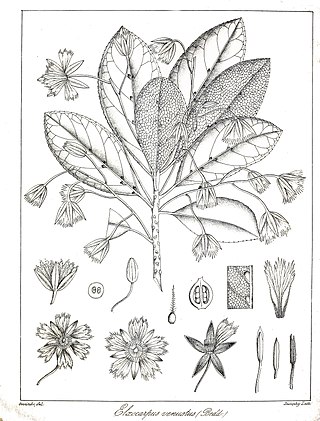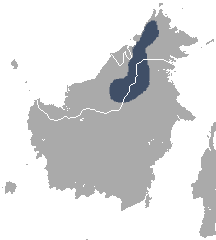
Elaeocarpus venustus is a species of flowering plant in the Elaeocarpaceae family. It is found only in the Western Ghats of Tamil Nadu state in southern India. It is Critically Endangered, and threatened by habitat loss.

The Matinan blue flycatcher, also known as the Matinan flycatcher, is a species of bird in the family Muscicapidae. It is endemic to the island of Sulawesi in Indonesia. Its natural habitat is subtropical or tropical moist montane forests, and the species is threatened by habitat loss.

The Bornean smooth-tailed treeshrew is a species of treeshrew in the family Tupaiidae. It is endemic to Borneo. Its natural habitat is subtropical or tropical dry forests. It is threatened by habitat loss.
Actinodaphne lawsonii is a species of plant in the family Lauraceae. It is endemic to the Western Ghats of southern India. It is threatened by habitat loss.
Ilex pallida is a species of plant in the family Aquifoliaceae. It is found in El Salvador, Honduras, Nicaragua, Costa Rica, and Panama. It is threatened by habitat loss.
Heptapleurum agamae is a species of plant in the family Araliaceae. It is endemic to the island of Palawan in the Philippines, where it grows in lowland rain forest on rocky hills. The species was collected only a single time in the 1920s. It is thought to be under pressure from habitat loss through deforestation.
Heptapleurum albidobracteatum is a species of plant in the family Araliaceae. It is an epiphytic shrub or a small tree endemic to the Philippines. It is known from Cebu, Leyte, and Bukidnon and Agusan provinces of Mindanao, where it grows in montane forests. The species has an estimated area of occupancy (AOO) of 16 km2, and an estimated extent of occurrence (EOO) of 30,697 km2.
Schefflera apiculata is a species of plant in the family Araliaceae. It is a tree endemic to the Maluku Islands in Indonesia. It has been collected in the Bacan Islands, Halmahera Island, and Ternate Island, growing in lowland rain forest.
Heptapleurum beccarianum is a species of plant in the family Araliaceae. It is a tree endemic to the Malaysian state of Sarawak on Borneo. It grows in lowland rain forest.
Heptapleurum bourdillonii is a species of plant in the family Araliaceae. It is a shrub or small tree endemic to Kerala in India. It has been collected in the Travancore Hills in the southern Western Ghats, where it grows in montane rain forest.

Heptapleurum bractescens is a species of plant in the family Araliaceae. It is native to New Guinea and to far northern Queensland in Australia. Originally named from a New Guinea collection, it was identified as a different species, Schefflera versteegii, when first discovered in Australia.
Sciodaphyllum chartaceum is a species of plant in the family Araliaceae. It is found in Costa Rica and Panama. It is threatened by habitat loss.
Heptapleurum capituliferum is a species of plant in the family Araliaceae. It is endemic to northern Sumatra. It is a small hemiepiphytic tree, which grows in montane rain forest and along forest edges in deep ravines.
Heptapleurum chapanum is a species of plant in the family Araliaceae. It is found in the Fansipan range of northern Vietnam and Yunnan Province of southern China. It grows in subtropical montane forest between 1,000 and 1,200 meters elevation.
Heptapleurum curranii is a species of plant in the family Araliaceae. It is a scrambling shrub or small tree endemic to the island of Palawan in the Philippines.
Heptapleurum fastigiatum is a species of plant in the family Araliaceae. It is a scrambling tree endemic to Java in Indonesia. It is known only from forest remnants on the island of Nusa Kambangan and possibly the Ujung Kulon Peninsula. It is an endangered species threatened by habitat loss.
Heptapleurum palawanense is a species of plant in the family Araliaceae. It is endemic to the island of Palawan in the Philippines. It is threatened by habitat loss.
Heptapleurum wrayi is a species of plant in the family Araliaceae. It is a tree native to Peninsular Malaysia and Peninsular Thailand. It is threatened by habitat loss.
Dryobalanops rappa is a species of plant in the family Dipterocarpaceae. The species name is derived from Iban and refers to the species habitat. This species is endemic to Borneo. It is found in at least one protected area, but is threatened elsewhere due to habitat loss, The IUCN has assessed the species as Endangered due to habitat damage by deforestation, mining, agriculture and fires.
Heptapleurum angiense is a flowering plant in the family Araliaceae. It is a tree endemic to western New Guinea.




